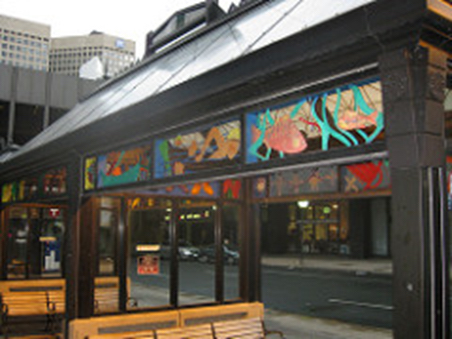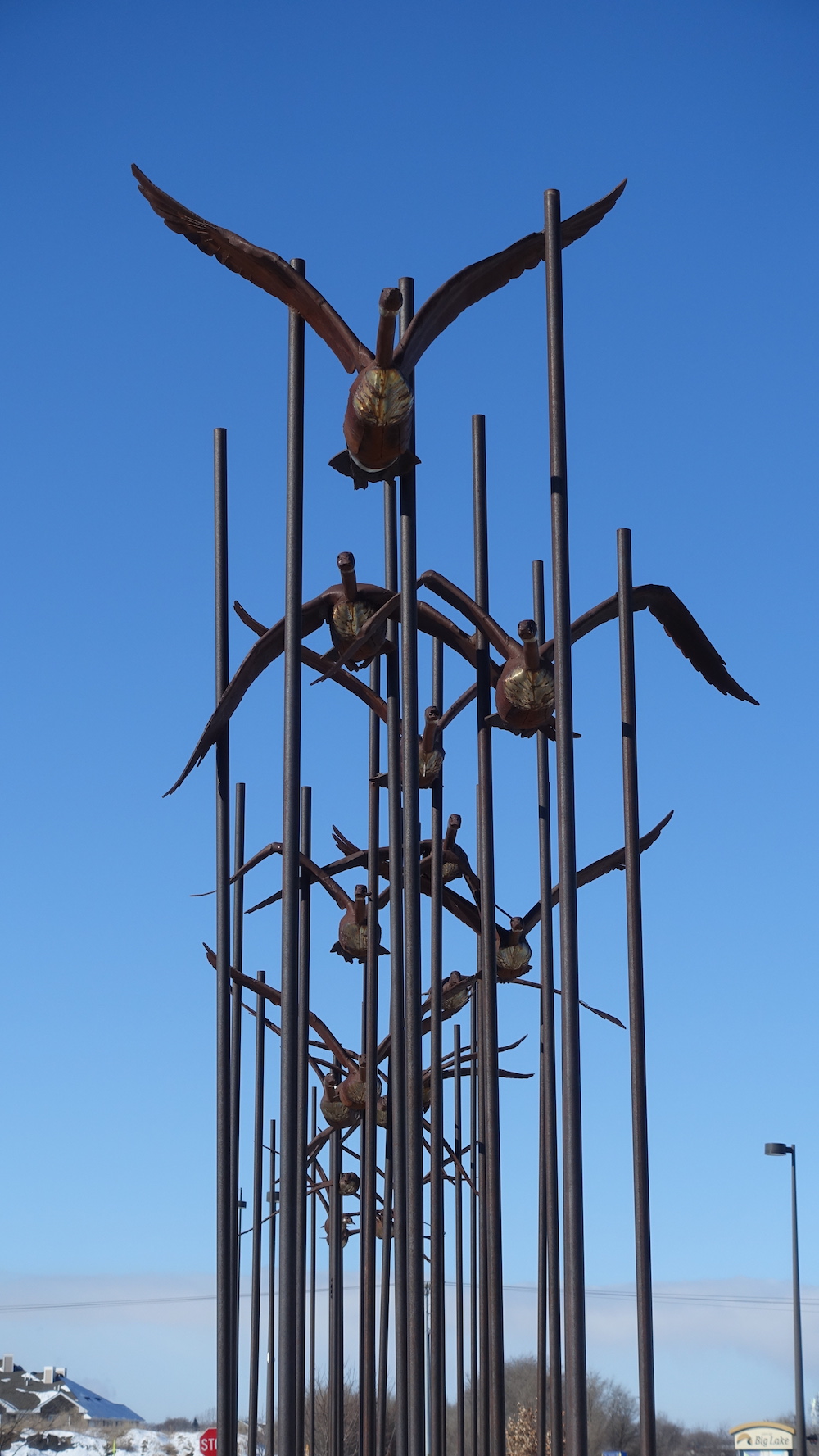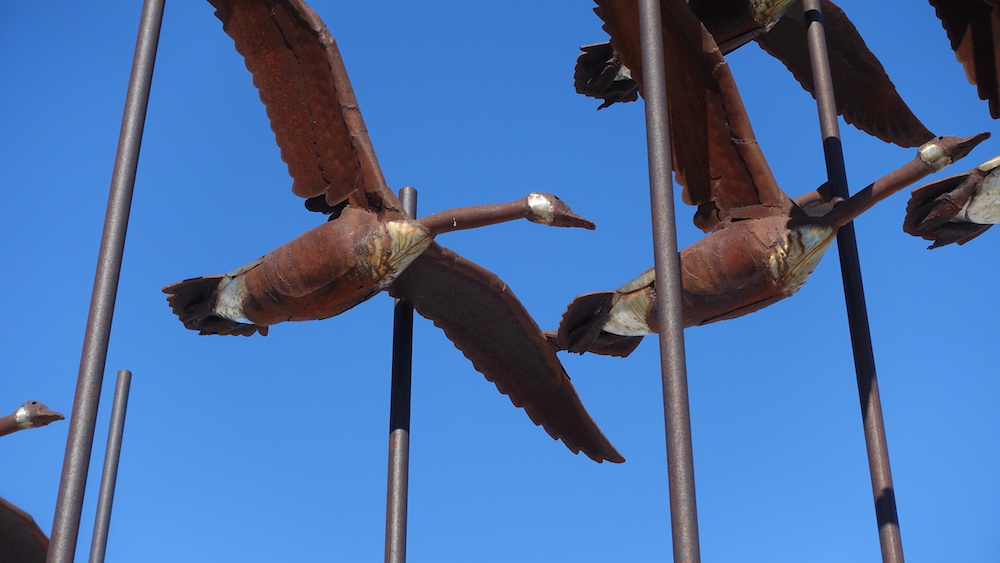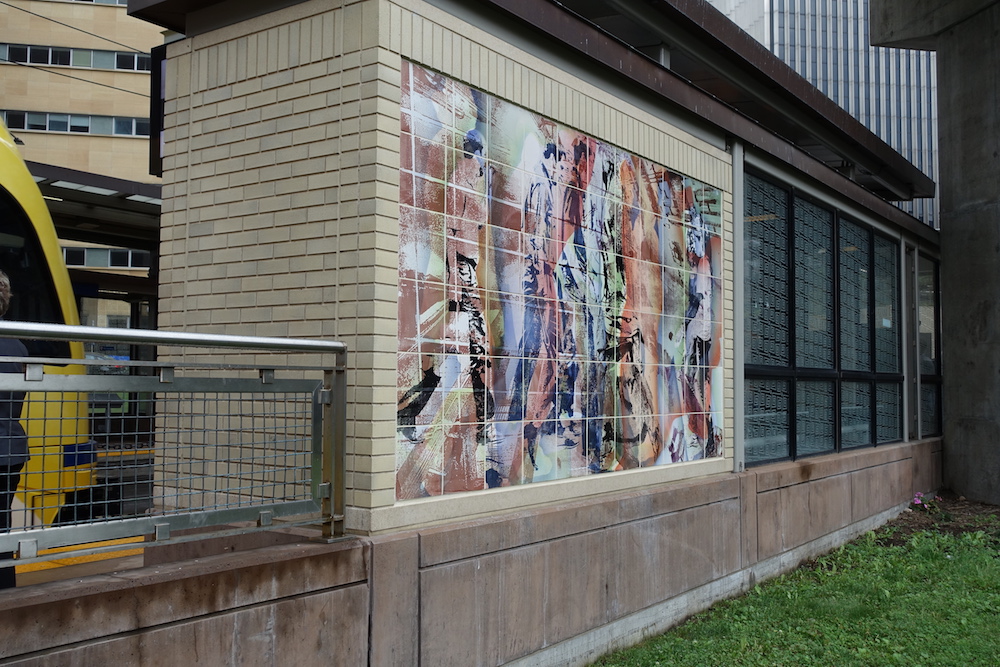Metro Transit’s Public Art in Transit has a program to support Facilities Maintenance through the use of public art. Areas that receive graffiti or vandalism are prime targets for reducing this behavior through public art. The walls on which these printed murals are installed were receiving a consistent amount of graffiti. The printed murals have a surface that makes the removal of graffiti very easy. So even if they don’t reduce the amount of graffiti, they make the removal of graffiti much easier. These murals will be observed and maintained for the next three years to see their effect on graffiti on the walls. If successful, Metro Transit will look at installing permanent murals.
The history of Public Art at Metro Transit
The first public art piece commissioned by Metro Transit was a painted metal sculpture by Marcia McEchron. The work was designed, fabricated, and installed along the top of a waiting shelter in downtown St. Paul on Cedar Street and 4th Street in 1995. The sculpture depicted images of Minnesota trees, animals, and events.

Over the next several years, Metro Transit dabbled a few more times with public art, mostly supporting the City of Minneapolis collection by providing a location for work owned by the City.
Then in 2000-2001, Metro Transit began planning the largest public art project in Minnesota, the art along the Hiawatha Line. Now known as the METRO Blue Line, the Hiawatha Line was the first light rail line in Minnesota and included public art integrated into each of the 18 original stations. To accomplish this, Metro Transit created design teams for each station comprised of architects and artists. With preliminary designs in hand, Joan Mondale, wife of former Vice President Walter Mondale and nationally recognized arts advocate, joined the cause along with David Allen, Public Art Administrator for the Hiawatha Line. More art and more artists were added to the project, resulting in an initial collection of 48 artworks created by 16 artists. Eventually, one more station was added bringing the total of public art pieces to 50.

The Blue Line effort was an early example, in Minnesota, of large-scale placemaking. The design teams met several times with the surrounding communities to create designs that complimented and reflected the neighborhoods surrounding the stations. Artists were fully integrated into the design teams and there were few limitations, other than budget and safety, as to what the artists could develop. On June 26, 2004, the Blue Line was opened from downtown Minneapolis to Fort Snelling Station and there was a celebration of the art at each station. On December 4, 2004, the rest of the line to Mall of America was completed and opened with much fanfare.
In 2009, with the development of the Northstar Commuter Rail Line from Minneapolis to Big Lake, two more pieces were created, one at the Minneapolis terminal at Target Field and one at the Big Lake terminal. The work at Target Field was developed as part of the overall public art program for Target Field and was administered by Mary Altman, Public Arts Administrator for the City of Minneapolis. The work at Big Lake, a series of flying Canada geese, was administered by consultant Richardson, Richter & Associates.


In 2009, there were also two new transit centers developed in downtown St. Paul and on Chicago Avenue in Minneapolis. Each of these transit centers received a public art piece. The Smith Avenue Ramp in St. Paul became home to a multi-media piece by Dick Huss, while Chicago Lake Transit Center became home to two ceramic tile murals by Ta-coumba Aiken.
As the public art at the new transit centers were being installed, Metro Transit was already planning for public art to be integrated into the design of a second light rail line, the METRO Green Line. Instead of developing design teams for each station, all 18 of the Green Line stations were designed by one firm that then worked with the different artists to integrate their work. Under the direction of Alicia Vapp, Metro Transit Stations and Streetscape Design Lead, seven artists were chosen, with most of the artists chosen to create art for as many as three stations. Many community meetings, coordinated by Robin Caufman, Community Engagement Manager, were held to capture the character of the neighborhoods around the stations. Because of this new design process, the works on the Green Line are more integrated into the structure of the stations and more attention was given to maintenance and sustainability.

Nearly 10 years to the day after the opening of the Blue Line, the METRO Green Line was opened and Metro Transit was home to one of the largest collections of public art in Minnesota.
In the meantime, some artwork on the Blue Line had begun to deteriorate, and Metro Transit did not have staff overseeing the care of the collection. Jill Hentges, Community Outreach Coordinator, took an interest in the collection and informally filled this role for several years. In 2013, under Hentges’ leadership, Metro Transit began working with conservator Kristin Cheronis to look at long term maintenance for the entire collection and in 2014 created the first annual survey of the collection. To ensure proper care of this significant asset, Metro Transit General Manager Brian Lamb and Engineering and Facilities Director Marilyn Porter created the position of Public Art Administrator in 2016.
Later in 2016, Metro Transit hired Mark Granlund to be Public Art Administrator. His task was to create a program that addressed maintenance of the existing collection, develop guidelines for the commissioning of new work and develop procedures for temporary art and performances.